Earthwork and Substructure Construction: Methods and Hazards Report
VerifiedAdded on 2022/08/27
|16
|3399
|20
Report
AI Summary
This report analyzes the methods and techniques used in civil engineering for earthwork and substructure construction, focusing on the development of an industrial park. It details equipment and techniques for various activities, including foundation construction (open cut, top-down, spread footing, raft foundation, open trench, and grillage foundations), piling works (vertical piles and bore piling), and drainage systems. The report also identifies potential hazards and risks associated with construction, such as slips, trips, falls, noise, hand-arm vibration syndrome, material handling issues, and asbestos exposure, while outlining relevant health and safety legislation, risk assessment, and safety plans. Finally, it discusses potential project management solutions for civil construction and infrastructure projects, emphasizing the coordination of various aspects of civil and architectural engineering to address challenges and create sustainable solutions. The report emphasizes the importance of careful planning, safety, and the use of appropriate methods to ensure successful project outcomes.

Title:
Institution Affiliation:
Name of Student:
Unit Title:
Submission Date:
Institution Affiliation:
Name of Student:
Unit Title:
Submission Date:
Paraphrase This Document
Need a fresh take? Get an instant paraphrase of this document with our AI Paraphraser
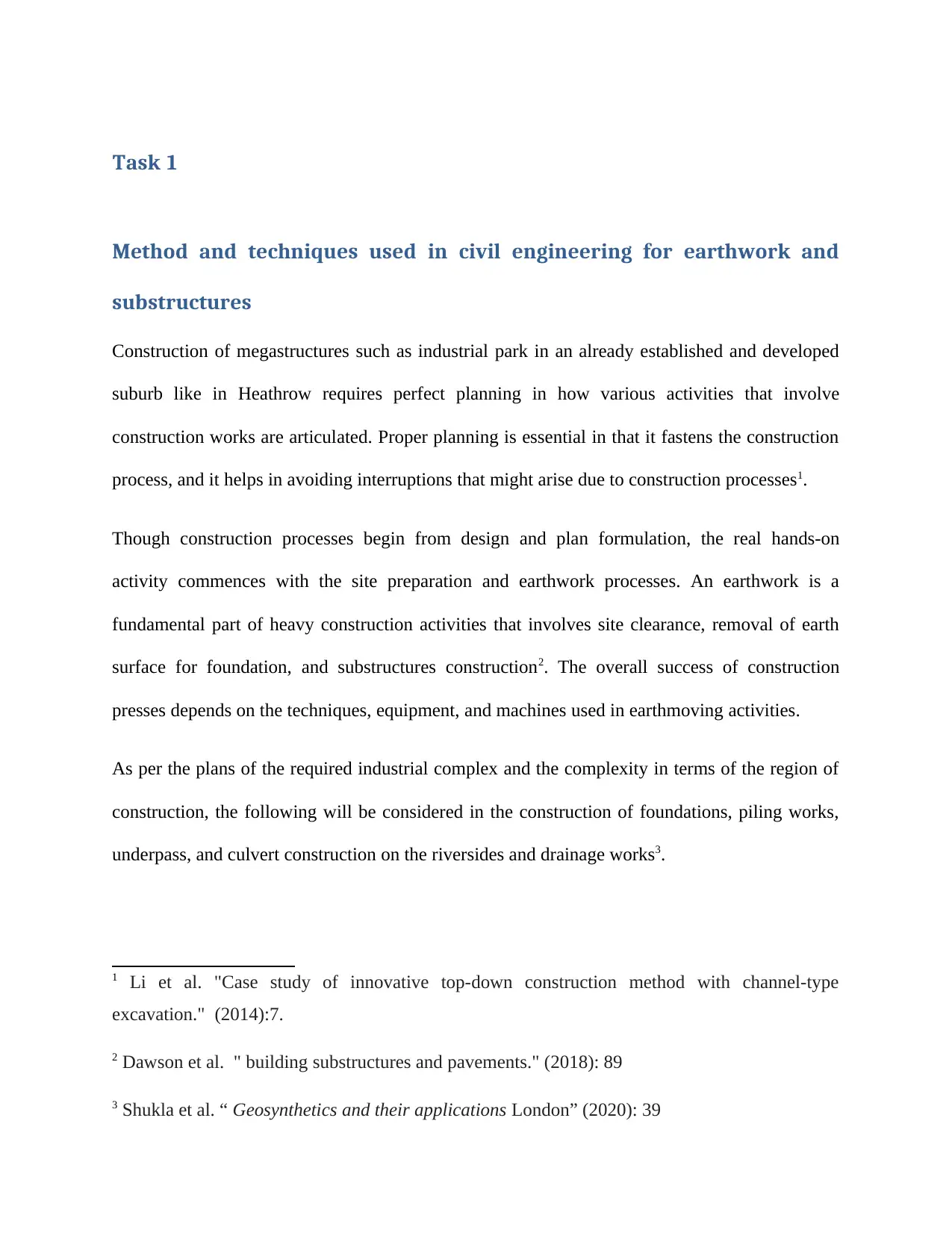
Task 1
Method and techniques used in civil engineering for earthwork and
substructures
Construction of megastructures such as industrial park in an already established and developed
suburb like in Heathrow requires perfect planning in how various activities that involve
construction works are articulated. Proper planning is essential in that it fastens the construction
process, and it helps in avoiding interruptions that might arise due to construction processes1.
Though construction processes begin from design and plan formulation, the real hands-on
activity commences with the site preparation and earthwork processes. An earthwork is a
fundamental part of heavy construction activities that involves site clearance, removal of earth
surface for foundation, and substructures construction2. The overall success of construction
presses depends on the techniques, equipment, and machines used in earthmoving activities.
As per the plans of the required industrial complex and the complexity in terms of the region of
construction, the following will be considered in the construction of foundations, piling works,
underpass, and culvert construction on the riversides and drainage works3.
1 Li et al. "Case study of innovative top-down construction method with channel-type
excavation." (2014):7.
2 Dawson et al. " building substructures and pavements." (2018): 89
3 Shukla et al. “ Geosynthetics and their applications London” (2020): 39
Method and techniques used in civil engineering for earthwork and
substructures
Construction of megastructures such as industrial park in an already established and developed
suburb like in Heathrow requires perfect planning in how various activities that involve
construction works are articulated. Proper planning is essential in that it fastens the construction
process, and it helps in avoiding interruptions that might arise due to construction processes1.
Though construction processes begin from design and plan formulation, the real hands-on
activity commences with the site preparation and earthwork processes. An earthwork is a
fundamental part of heavy construction activities that involves site clearance, removal of earth
surface for foundation, and substructures construction2. The overall success of construction
presses depends on the techniques, equipment, and machines used in earthmoving activities.
As per the plans of the required industrial complex and the complexity in terms of the region of
construction, the following will be considered in the construction of foundations, piling works,
underpass, and culvert construction on the riversides and drainage works3.
1 Li et al. "Case study of innovative top-down construction method with channel-type
excavation." (2014):7.
2 Dawson et al. " building substructures and pavements." (2018): 89
3 Shukla et al. “ Geosynthetics and their applications London” (2020): 39

Equipment and techniques to be used in Industrial Park Earthworks
Earthworks and substructure constructions involve various activities that require heavy
equipment and machines with specified methods depending on the nature of the building
involved. Since the construction of industrial park buildings will involve high vibrating and
heavy machines that will be used in the manufacturing of various products4. Therefore the
foundation, excavation, and pilling works need to be of high strength to sustain the vibration
effect of production machines. The following are techniques, equipment, and methods for
various activities
Equipment and Uses in Earthworks
Earthwork Equipment Operational Use
Bulldozers Will be used in short distance earthwork
operations that involve loosening of rocky
grounds
Motor graders Graders will be used in grading and shaping
slopes and pavement layers
Cranes Used in lifting, handling and placing of excavated
materials into trucks
Wagons and trucks Used for general transportations and hauling
operations
Excavators Used for large volume earth and land fill removal
4 Sawhney et al. "Construction project simulation using CYCLONE." (2018): 25.
Earthworks and substructure constructions involve various activities that require heavy
equipment and machines with specified methods depending on the nature of the building
involved. Since the construction of industrial park buildings will involve high vibrating and
heavy machines that will be used in the manufacturing of various products4. Therefore the
foundation, excavation, and pilling works need to be of high strength to sustain the vibration
effect of production machines. The following are techniques, equipment, and methods for
various activities
Equipment and Uses in Earthworks
Earthwork Equipment Operational Use
Bulldozers Will be used in short distance earthwork
operations that involve loosening of rocky
grounds
Motor graders Graders will be used in grading and shaping
slopes and pavement layers
Cranes Used in lifting, handling and placing of excavated
materials into trucks
Wagons and trucks Used for general transportations and hauling
operations
Excavators Used for large volume earth and land fill removal
4 Sawhney et al. "Construction project simulation using CYCLONE." (2018): 25.
⊘ This is a preview!⊘
Do you want full access?
Subscribe today to unlock all pages.

Trusted by 1+ million students worldwide
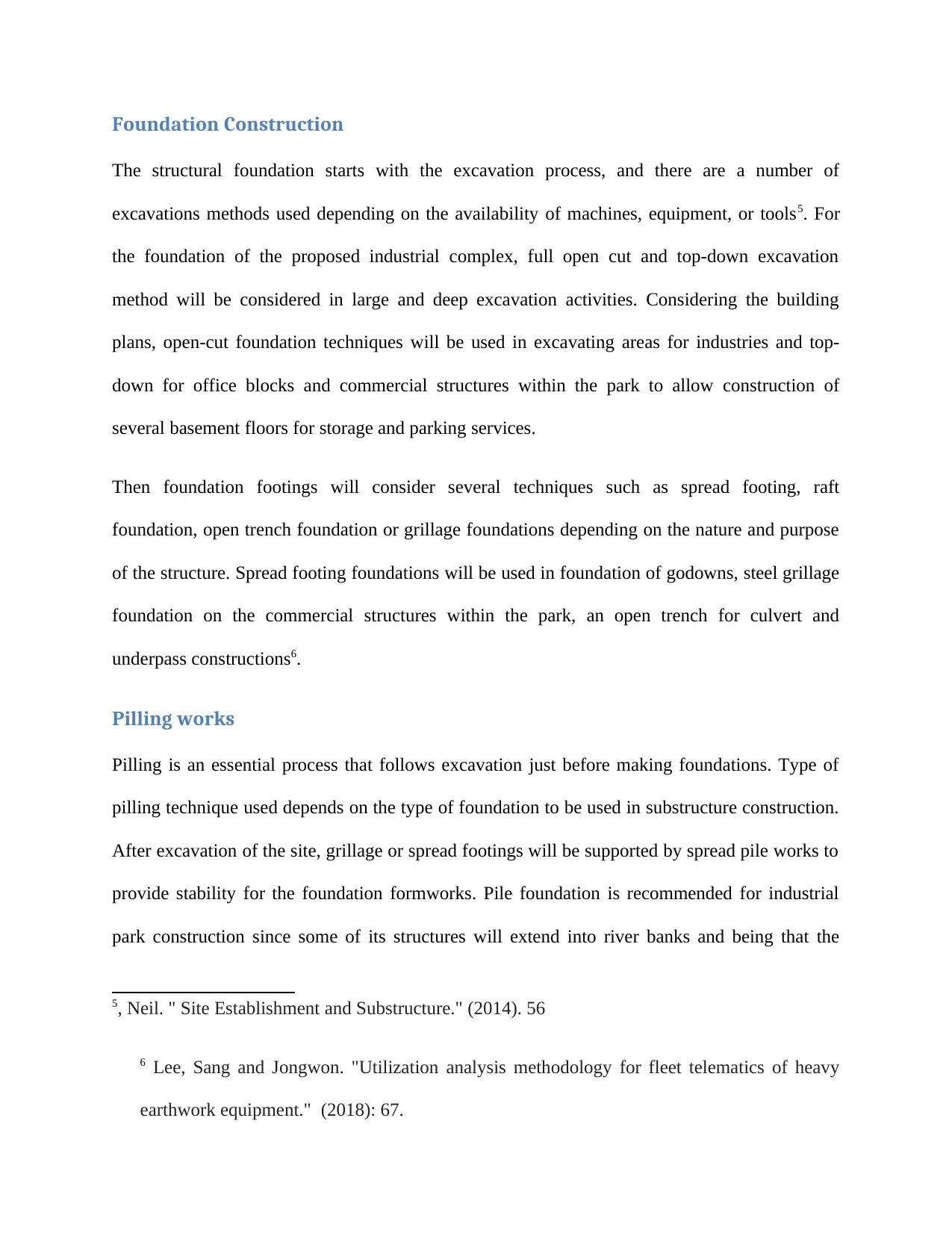
Foundation Construction
The structural foundation starts with the excavation process, and there are a number of
excavations methods used depending on the availability of machines, equipment, or tools5. For
the foundation of the proposed industrial complex, full open cut and top-down excavation
method will be considered in large and deep excavation activities. Considering the building
plans, open-cut foundation techniques will be used in excavating areas for industries and top-
down for office blocks and commercial structures within the park to allow construction of
several basement floors for storage and parking services.
Then foundation footings will consider several techniques such as spread footing, raft
foundation, open trench foundation or grillage foundations depending on the nature and purpose
of the structure. Spread footing foundations will be used in foundation of godowns, steel grillage
foundation on the commercial structures within the park, an open trench for culvert and
underpass constructions6.
Pilling works
Pilling is an essential process that follows excavation just before making foundations. Type of
pilling technique used depends on the type of foundation to be used in substructure construction.
After excavation of the site, grillage or spread footings will be supported by spread pile works to
provide stability for the foundation formworks. Pile foundation is recommended for industrial
park construction since some of its structures will extend into river banks and being that the
5, Neil. " Site Establishment and Substructure." (2014). 56
6 Lee, Sang and Jongwon. "Utilization analysis methodology for fleet telematics of heavy
earthwork equipment." (2018): 67.
The structural foundation starts with the excavation process, and there are a number of
excavations methods used depending on the availability of machines, equipment, or tools5. For
the foundation of the proposed industrial complex, full open cut and top-down excavation
method will be considered in large and deep excavation activities. Considering the building
plans, open-cut foundation techniques will be used in excavating areas for industries and top-
down for office blocks and commercial structures within the park to allow construction of
several basement floors for storage and parking services.
Then foundation footings will consider several techniques such as spread footing, raft
foundation, open trench foundation or grillage foundations depending on the nature and purpose
of the structure. Spread footing foundations will be used in foundation of godowns, steel grillage
foundation on the commercial structures within the park, an open trench for culvert and
underpass constructions6.
Pilling works
Pilling is an essential process that follows excavation just before making foundations. Type of
pilling technique used depends on the type of foundation to be used in substructure construction.
After excavation of the site, grillage or spread footings will be supported by spread pile works to
provide stability for the foundation formworks. Pile foundation is recommended for industrial
park construction since some of its structures will extend into river banks and being that the
5, Neil. " Site Establishment and Substructure." (2014). 56
6 Lee, Sang and Jongwon. "Utilization analysis methodology for fleet telematics of heavy
earthwork equipment." (2018): 67.
Paraphrase This Document
Need a fresh take? Get an instant paraphrase of this document with our AI Paraphraser
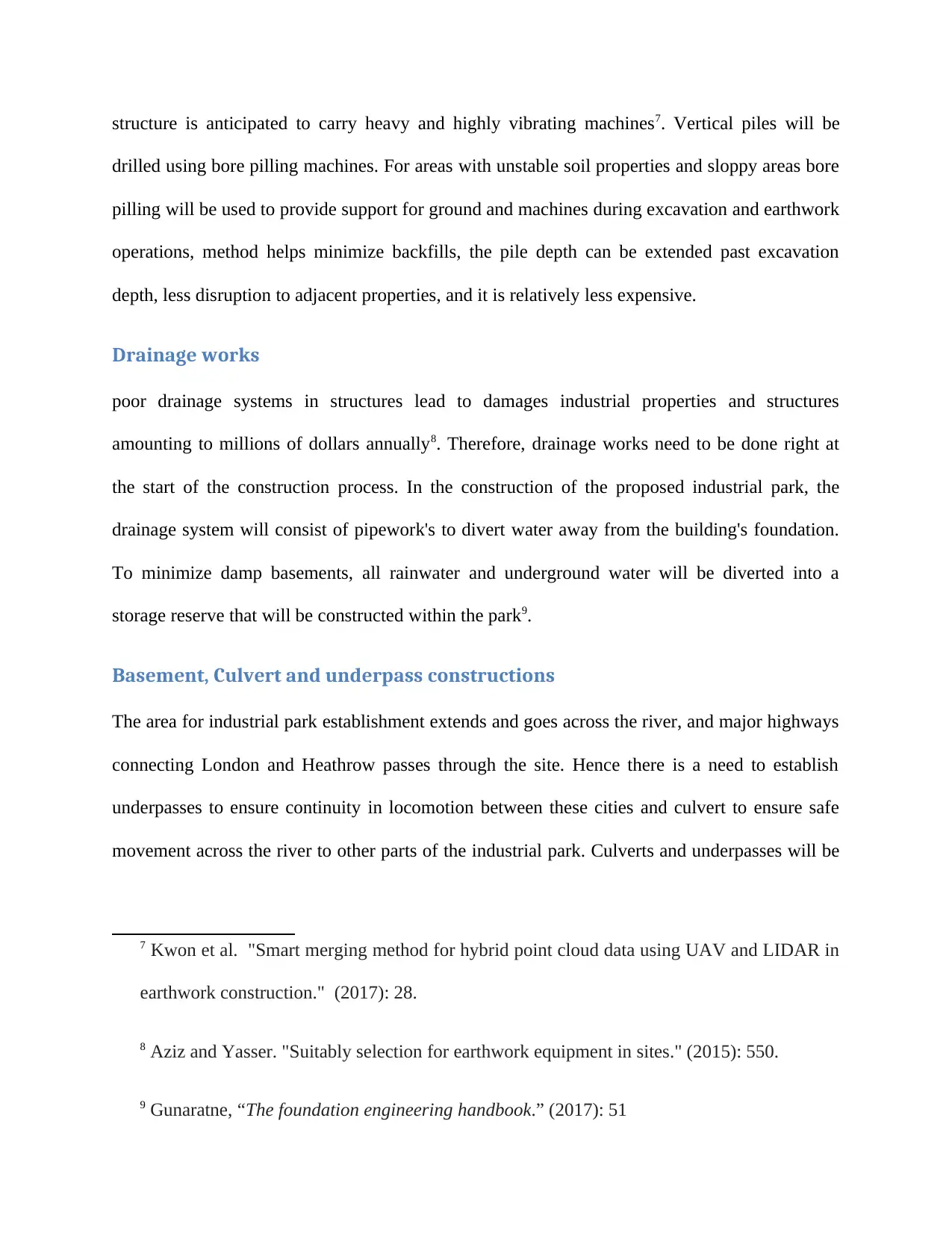
structure is anticipated to carry heavy and highly vibrating machines7. Vertical piles will be
drilled using bore pilling machines. For areas with unstable soil properties and sloppy areas bore
pilling will be used to provide support for ground and machines during excavation and earthwork
operations, method helps minimize backfills, the pile depth can be extended past excavation
depth, less disruption to adjacent properties, and it is relatively less expensive.
Drainage works
poor drainage systems in structures lead to damages industrial properties and structures
amounting to millions of dollars annually8. Therefore, drainage works need to be done right at
the start of the construction process. In the construction of the proposed industrial park, the
drainage system will consist of pipework's to divert water away from the building's foundation.
To minimize damp basements, all rainwater and underground water will be diverted into a
storage reserve that will be constructed within the park9.
Basement, Culvert and underpass constructions
The area for industrial park establishment extends and goes across the river, and major highways
connecting London and Heathrow passes through the site. Hence there is a need to establish
underpasses to ensure continuity in locomotion between these cities and culvert to ensure safe
movement across the river to other parts of the industrial park. Culverts and underpasses will be
7 Kwon et al. "Smart merging method for hybrid point cloud data using UAV and LIDAR in
earthwork construction." (2017): 28.
8 Aziz and Yasser. "Suitably selection for earthwork equipment in sites." (2015): 550.
9 Gunaratne, “The foundation engineering handbook.” (2017): 51
drilled using bore pilling machines. For areas with unstable soil properties and sloppy areas bore
pilling will be used to provide support for ground and machines during excavation and earthwork
operations, method helps minimize backfills, the pile depth can be extended past excavation
depth, less disruption to adjacent properties, and it is relatively less expensive.
Drainage works
poor drainage systems in structures lead to damages industrial properties and structures
amounting to millions of dollars annually8. Therefore, drainage works need to be done right at
the start of the construction process. In the construction of the proposed industrial park, the
drainage system will consist of pipework's to divert water away from the building's foundation.
To minimize damp basements, all rainwater and underground water will be diverted into a
storage reserve that will be constructed within the park9.
Basement, Culvert and underpass constructions
The area for industrial park establishment extends and goes across the river, and major highways
connecting London and Heathrow passes through the site. Hence there is a need to establish
underpasses to ensure continuity in locomotion between these cities and culvert to ensure safe
movement across the river to other parts of the industrial park. Culverts and underpasses will be
7 Kwon et al. "Smart merging method for hybrid point cloud data using UAV and LIDAR in
earthwork construction." (2017): 28.
8 Aziz and Yasser. "Suitably selection for earthwork equipment in sites." (2015): 550.
9 Gunaratne, “The foundation engineering handbook.” (2017): 51
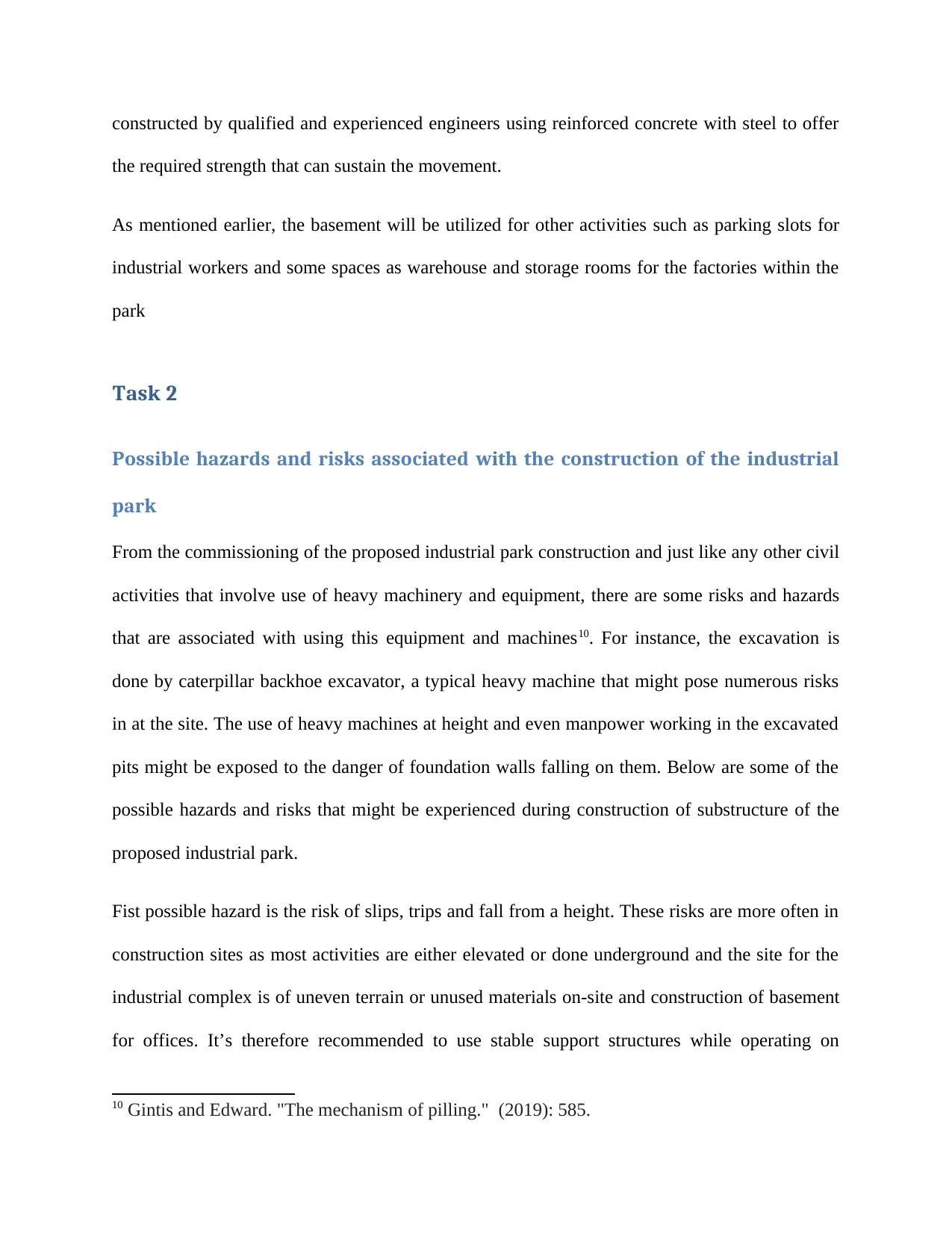
constructed by qualified and experienced engineers using reinforced concrete with steel to offer
the required strength that can sustain the movement.
As mentioned earlier, the basement will be utilized for other activities such as parking slots for
industrial workers and some spaces as warehouse and storage rooms for the factories within the
park
Task 2
Possible hazards and risks associated with the construction of the industrial
park
From the commissioning of the proposed industrial park construction and just like any other civil
activities that involve use of heavy machinery and equipment, there are some risks and hazards
that are associated with using this equipment and machines10. For instance, the excavation is
done by caterpillar backhoe excavator, a typical heavy machine that might pose numerous risks
in at the site. The use of heavy machines at height and even manpower working in the excavated
pits might be exposed to the danger of foundation walls falling on them. Below are some of the
possible hazards and risks that might be experienced during construction of substructure of the
proposed industrial park.
Fist possible hazard is the risk of slips, trips and fall from a height. These risks are more often in
construction sites as most activities are either elevated or done underground and the site for the
industrial complex is of uneven terrain or unused materials on-site and construction of basement
for offices. It’s therefore recommended to use stable support structures while operating on
10 Gintis and Edward. "The mechanism of pilling." (2019): 585.
the required strength that can sustain the movement.
As mentioned earlier, the basement will be utilized for other activities such as parking slots for
industrial workers and some spaces as warehouse and storage rooms for the factories within the
park
Task 2
Possible hazards and risks associated with the construction of the industrial
park
From the commissioning of the proposed industrial park construction and just like any other civil
activities that involve use of heavy machinery and equipment, there are some risks and hazards
that are associated with using this equipment and machines10. For instance, the excavation is
done by caterpillar backhoe excavator, a typical heavy machine that might pose numerous risks
in at the site. The use of heavy machines at height and even manpower working in the excavated
pits might be exposed to the danger of foundation walls falling on them. Below are some of the
possible hazards and risks that might be experienced during construction of substructure of the
proposed industrial park.
Fist possible hazard is the risk of slips, trips and fall from a height. These risks are more often in
construction sites as most activities are either elevated or done underground and the site for the
industrial complex is of uneven terrain or unused materials on-site and construction of basement
for offices. It’s therefore recommended to use stable support structures while operating on
10 Gintis and Edward. "The mechanism of pilling." (2019): 585.
⊘ This is a preview!⊘
Do you want full access?
Subscribe today to unlock all pages.

Trusted by 1+ million students worldwide
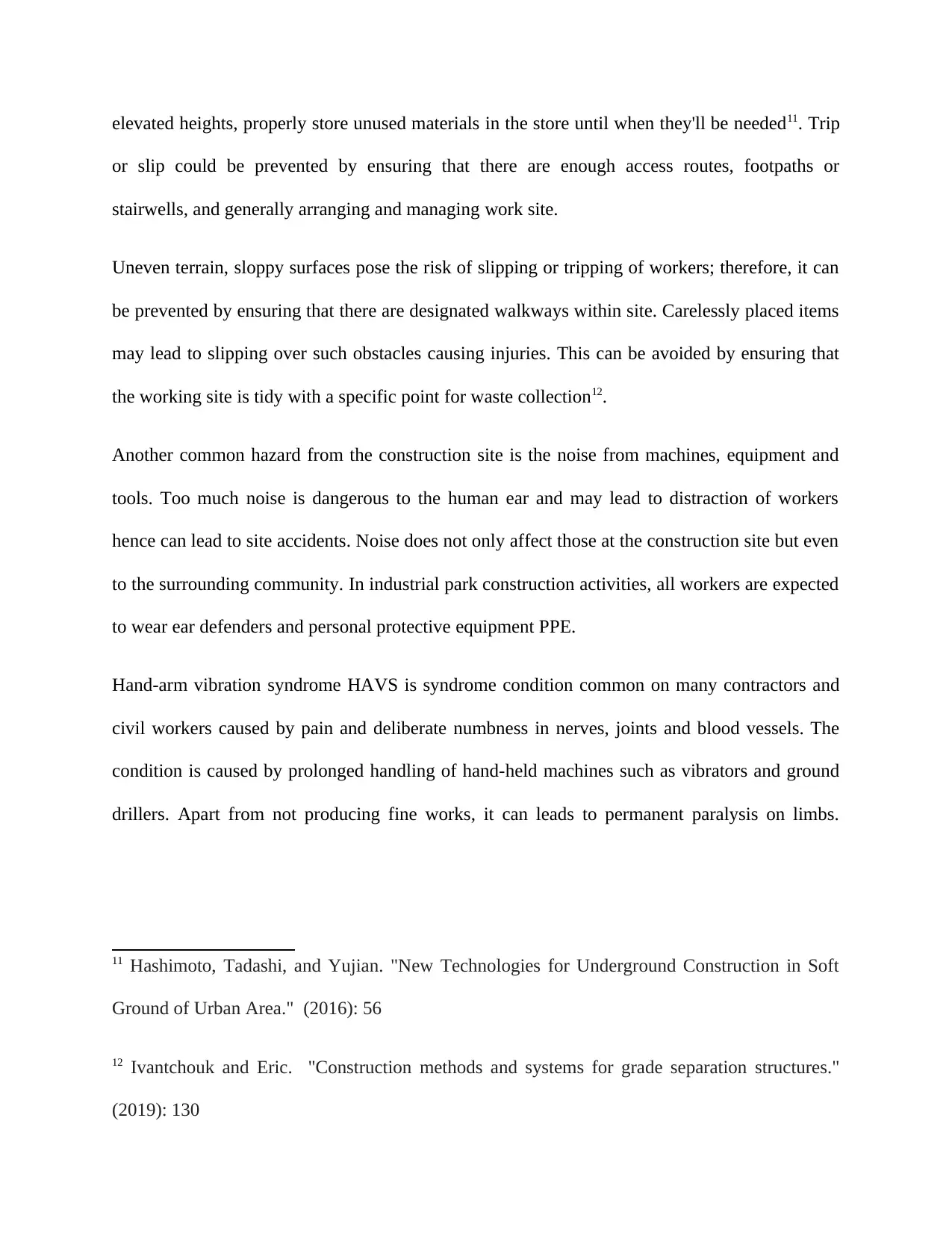
elevated heights, properly store unused materials in the store until when they'll be needed11. Trip
or slip could be prevented by ensuring that there are enough access routes, footpaths or
stairwells, and generally arranging and managing work site.
Uneven terrain, sloppy surfaces pose the risk of slipping or tripping of workers; therefore, it can
be prevented by ensuring that there are designated walkways within site. Carelessly placed items
may lead to slipping over such obstacles causing injuries. This can be avoided by ensuring that
the working site is tidy with a specific point for waste collection12.
Another common hazard from the construction site is the noise from machines, equipment and
tools. Too much noise is dangerous to the human ear and may lead to distraction of workers
hence can lead to site accidents. Noise does not only affect those at the construction site but even
to the surrounding community. In industrial park construction activities, all workers are expected
to wear ear defenders and personal protective equipment PPE.
Hand-arm vibration syndrome HAVS is syndrome condition common on many contractors and
civil workers caused by pain and deliberate numbness in nerves, joints and blood vessels. The
condition is caused by prolonged handling of hand-held machines such as vibrators and ground
drillers. Apart from not producing fine works, it can leads to permanent paralysis on limbs.
11 Hashimoto, Tadashi, and Yujian. "New Technologies for Underground Construction in Soft
Ground of Urban Area." (2016): 56
12 Ivantchouk and Eric. "Construction methods and systems for grade separation structures."
(2019): 130
or slip could be prevented by ensuring that there are enough access routes, footpaths or
stairwells, and generally arranging and managing work site.
Uneven terrain, sloppy surfaces pose the risk of slipping or tripping of workers; therefore, it can
be prevented by ensuring that there are designated walkways within site. Carelessly placed items
may lead to slipping over such obstacles causing injuries. This can be avoided by ensuring that
the working site is tidy with a specific point for waste collection12.
Another common hazard from the construction site is the noise from machines, equipment and
tools. Too much noise is dangerous to the human ear and may lead to distraction of workers
hence can lead to site accidents. Noise does not only affect those at the construction site but even
to the surrounding community. In industrial park construction activities, all workers are expected
to wear ear defenders and personal protective equipment PPE.
Hand-arm vibration syndrome HAVS is syndrome condition common on many contractors and
civil workers caused by pain and deliberate numbness in nerves, joints and blood vessels. The
condition is caused by prolonged handling of hand-held machines such as vibrators and ground
drillers. Apart from not producing fine works, it can leads to permanent paralysis on limbs.
11 Hashimoto, Tadashi, and Yujian. "New Technologies for Underground Construction in Soft
Ground of Urban Area." (2016): 56
12 Ivantchouk and Eric. "Construction methods and systems for grade separation structures."
(2019): 130
Paraphrase This Document
Need a fresh take? Get an instant paraphrase of this document with our AI Paraphraser

Proper and effective protection gears should be used by workers operating such equipment to
avoid HAVS syndrome13.
Material handling within site, be it manual or automatic handling poses a potential risk in the
construction site14. For instance, when materials are manually handled there is the possibility of
fall or when automatically handled, there is the possibility of machine failure, thus posing a
danger to operators. Risks associated with material handling can be avoided by ensuring that
individuals involved are properly trained and does not carry out such operations for a long time
to avoid fatigue. Machines used in the handling of materials such as cranes need frequent and
regular servicing to establish their workability and efficiency before operating on them.
Hazards of asbestos, this occurs when the excavation process interferes with the fibrous of
naturally occurring minerals that contain asbestos. When asbestos fibres are released into the
atmosphere, the possibility of human inhaling these fibres are high and might cause serious and
fatal diseases such as asbestosis, pleural thickening or cancer. This is a potential risk since
previous reports shown that most areas around London have asbestos and nearly 5000 people die
from the effects of exposure to asbestos fibres in the UK every year.
Health and safety legislation and codes of practice related to civil engineering
in the UK
Construction, just like other activities, are guided and controlled by some set of codes of practice
and legislation that ensures that the health and safety of stakeholders involved in construction
processes are safeguarded. In general, these set of codes and legislations are entailed in the
13 Hwang,. "Prefabricated culvert system." (2018): 24
14 Carter and Simon. "Safety hazard identification on construction projects." (2016): 204.
avoid HAVS syndrome13.
Material handling within site, be it manual or automatic handling poses a potential risk in the
construction site14. For instance, when materials are manually handled there is the possibility of
fall or when automatically handled, there is the possibility of machine failure, thus posing a
danger to operators. Risks associated with material handling can be avoided by ensuring that
individuals involved are properly trained and does not carry out such operations for a long time
to avoid fatigue. Machines used in the handling of materials such as cranes need frequent and
regular servicing to establish their workability and efficiency before operating on them.
Hazards of asbestos, this occurs when the excavation process interferes with the fibrous of
naturally occurring minerals that contain asbestos. When asbestos fibres are released into the
atmosphere, the possibility of human inhaling these fibres are high and might cause serious and
fatal diseases such as asbestosis, pleural thickening or cancer. This is a potential risk since
previous reports shown that most areas around London have asbestos and nearly 5000 people die
from the effects of exposure to asbestos fibres in the UK every year.
Health and safety legislation and codes of practice related to civil engineering
in the UK
Construction, just like other activities, are guided and controlled by some set of codes of practice
and legislation that ensures that the health and safety of stakeholders involved in construction
processes are safeguarded. In general, these set of codes and legislations are entailed in the
13 Hwang,. "Prefabricated culvert system." (2018): 24
14 Carter and Simon. "Safety hazard identification on construction projects." (2016): 204.
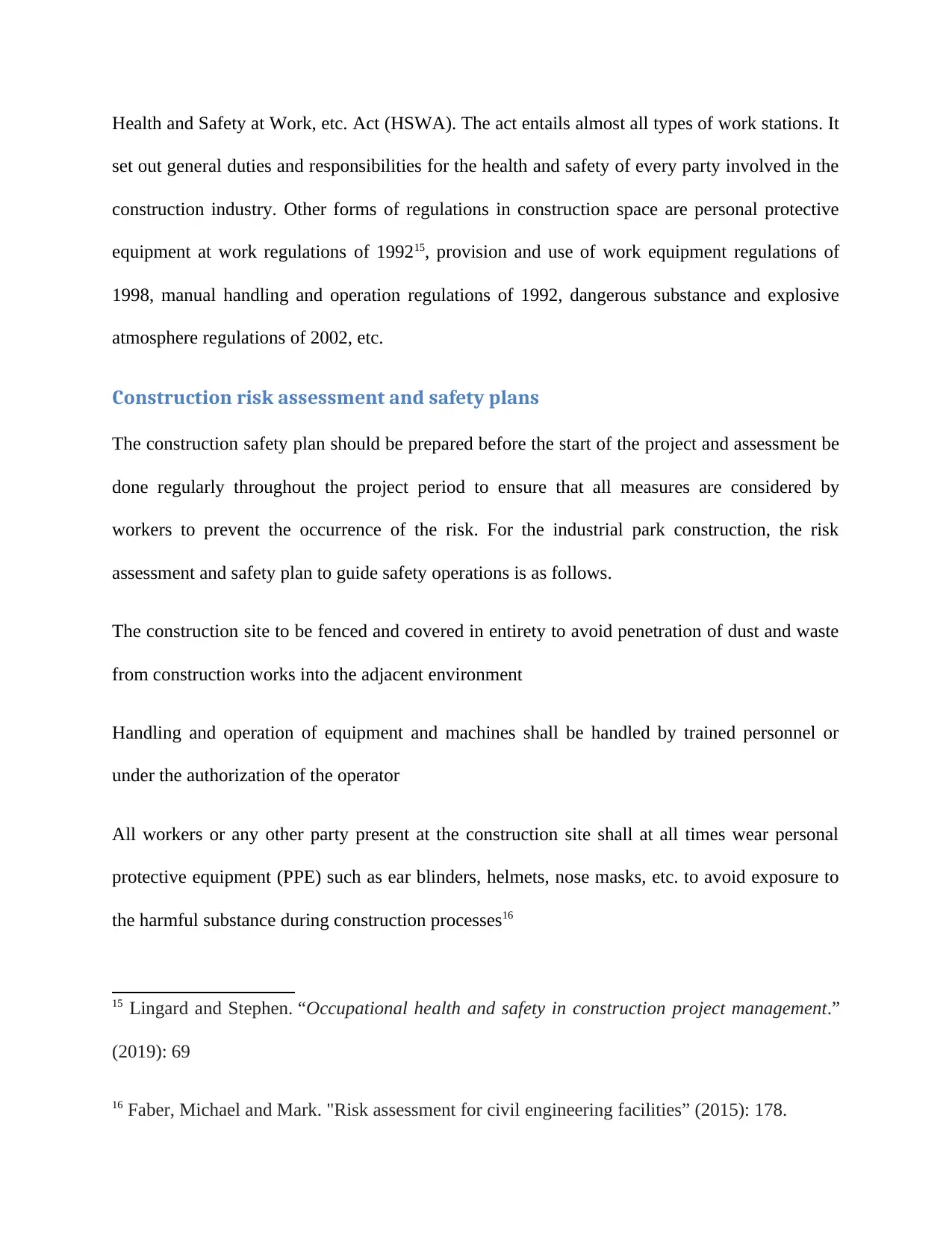
Health and Safety at Work, etc. Act (HSWA). The act entails almost all types of work stations. It
set out general duties and responsibilities for the health and safety of every party involved in the
construction industry. Other forms of regulations in construction space are personal protective
equipment at work regulations of 199215, provision and use of work equipment regulations of
1998, manual handling and operation regulations of 1992, dangerous substance and explosive
atmosphere regulations of 2002, etc.
Construction risk assessment and safety plans
The construction safety plan should be prepared before the start of the project and assessment be
done regularly throughout the project period to ensure that all measures are considered by
workers to prevent the occurrence of the risk. For the industrial park construction, the risk
assessment and safety plan to guide safety operations is as follows.
The construction site to be fenced and covered in entirety to avoid penetration of dust and waste
from construction works into the adjacent environment
Handling and operation of equipment and machines shall be handled by trained personnel or
under the authorization of the operator
All workers or any other party present at the construction site shall at all times wear personal
protective equipment (PPE) such as ear blinders, helmets, nose masks, etc. to avoid exposure to
the harmful substance during construction processes16
15 Lingard and Stephen. “Occupational health and safety in construction project management.”
(2019): 69
16 Faber, Michael and Mark. "Risk assessment for civil engineering facilities” (2015): 178.
set out general duties and responsibilities for the health and safety of every party involved in the
construction industry. Other forms of regulations in construction space are personal protective
equipment at work regulations of 199215, provision and use of work equipment regulations of
1998, manual handling and operation regulations of 1992, dangerous substance and explosive
atmosphere regulations of 2002, etc.
Construction risk assessment and safety plans
The construction safety plan should be prepared before the start of the project and assessment be
done regularly throughout the project period to ensure that all measures are considered by
workers to prevent the occurrence of the risk. For the industrial park construction, the risk
assessment and safety plan to guide safety operations is as follows.
The construction site to be fenced and covered in entirety to avoid penetration of dust and waste
from construction works into the adjacent environment
Handling and operation of equipment and machines shall be handled by trained personnel or
under the authorization of the operator
All workers or any other party present at the construction site shall at all times wear personal
protective equipment (PPE) such as ear blinders, helmets, nose masks, etc. to avoid exposure to
the harmful substance during construction processes16
15 Lingard and Stephen. “Occupational health and safety in construction project management.”
(2019): 69
16 Faber, Michael and Mark. "Risk assessment for civil engineering facilities” (2015): 178.
⊘ This is a preview!⊘
Do you want full access?
Subscribe today to unlock all pages.

Trusted by 1+ million students worldwide
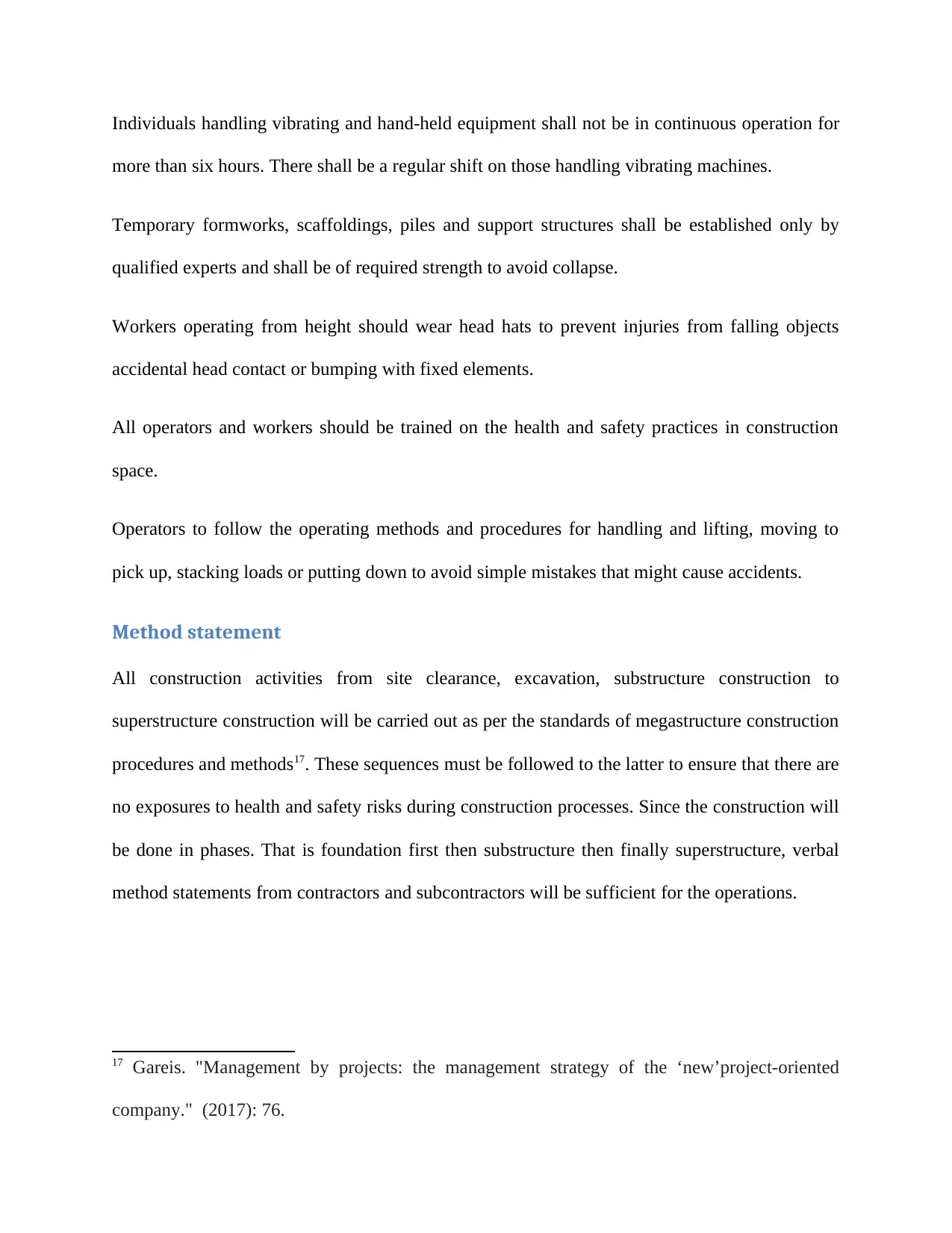
Individuals handling vibrating and hand-held equipment shall not be in continuous operation for
more than six hours. There shall be a regular shift on those handling vibrating machines.
Temporary formworks, scaffoldings, piles and support structures shall be established only by
qualified experts and shall be of required strength to avoid collapse.
Workers operating from height should wear head hats to prevent injuries from falling objects
accidental head contact or bumping with fixed elements.
All operators and workers should be trained on the health and safety practices in construction
space.
Operators to follow the operating methods and procedures for handling and lifting, moving to
pick up, stacking loads or putting down to avoid simple mistakes that might cause accidents.
Method statement
All construction activities from site clearance, excavation, substructure construction to
superstructure construction will be carried out as per the standards of megastructure construction
procedures and methods17. These sequences must be followed to the latter to ensure that there are
no exposures to health and safety risks during construction processes. Since the construction will
be done in phases. That is foundation first then substructure then finally superstructure, verbal
method statements from contractors and subcontractors will be sufficient for the operations.
17 Gareis. "Management by projects: the management strategy of the ‘new’project-oriented
company." (2017): 76.
more than six hours. There shall be a regular shift on those handling vibrating machines.
Temporary formworks, scaffoldings, piles and support structures shall be established only by
qualified experts and shall be of required strength to avoid collapse.
Workers operating from height should wear head hats to prevent injuries from falling objects
accidental head contact or bumping with fixed elements.
All operators and workers should be trained on the health and safety practices in construction
space.
Operators to follow the operating methods and procedures for handling and lifting, moving to
pick up, stacking loads or putting down to avoid simple mistakes that might cause accidents.
Method statement
All construction activities from site clearance, excavation, substructure construction to
superstructure construction will be carried out as per the standards of megastructure construction
procedures and methods17. These sequences must be followed to the latter to ensure that there are
no exposures to health and safety risks during construction processes. Since the construction will
be done in phases. That is foundation first then substructure then finally superstructure, verbal
method statements from contractors and subcontractors will be sufficient for the operations.
17 Gareis. "Management by projects: the management strategy of the ‘new’project-oriented
company." (2017): 76.
Paraphrase This Document
Need a fresh take? Get an instant paraphrase of this document with our AI Paraphraser

Task 3
Potential project management solution
Civil constructions and infrastructure projects, in general, are aimed towards solving particular
challenges experienced by mankind. For instance, the construction of highways, bridges,
airports, etc. are aimed at easing movement between places. Therefore project management is the
process of coordinating various aspects of civil and architectural engineering to develop a
sustainable solution to problems facing humanity18. However civil activities are associated with
some geotechnical and environmental challenges. Construction of an industrial park will be
accompanied with a lot of waste production from the site, disruption of vegetation, noise
pollution from operating machines, river pollution and littering of streets.
These environmental problems can be controlled by ensuring that there are proper waste disposal
strategies within the site, all fluid wastes from construction are treated before released into water
stream, and the construction perimeter be covered by scaffoldings to filter dust from spreading to
suburbs. Geotechnical interference is quite hard to avoid since they are caused by vibration of
machines that are necessary for construction works.
The project site extends over to the banks of river Thames and passes across highways.
Therefore it requires the construction of culverts and underpasses that are of high standard and
quality to ensure the safety of the operators. The project brief presents the most crucial and
technical analysis of such structural construction and are examined by the national construction
agencies for accreditation before the actual construction process.
18 Das and Nagaratnam. “ Fundamentals of geotechnical engineering”. (2016): 56
Potential project management solution
Civil constructions and infrastructure projects, in general, are aimed towards solving particular
challenges experienced by mankind. For instance, the construction of highways, bridges,
airports, etc. are aimed at easing movement between places. Therefore project management is the
process of coordinating various aspects of civil and architectural engineering to develop a
sustainable solution to problems facing humanity18. However civil activities are associated with
some geotechnical and environmental challenges. Construction of an industrial park will be
accompanied with a lot of waste production from the site, disruption of vegetation, noise
pollution from operating machines, river pollution and littering of streets.
These environmental problems can be controlled by ensuring that there are proper waste disposal
strategies within the site, all fluid wastes from construction are treated before released into water
stream, and the construction perimeter be covered by scaffoldings to filter dust from spreading to
suburbs. Geotechnical interference is quite hard to avoid since they are caused by vibration of
machines that are necessary for construction works.
The project site extends over to the banks of river Thames and passes across highways.
Therefore it requires the construction of culverts and underpasses that are of high standard and
quality to ensure the safety of the operators. The project brief presents the most crucial and
technical analysis of such structural construction and are examined by the national construction
agencies for accreditation before the actual construction process.
18 Das and Nagaratnam. “ Fundamentals of geotechnical engineering”. (2016): 56

A typical proposal that would ensure that construction projects are done in a standard manner
would be through constant monitoring of the process as it unfolds from one stage to another.
This would help in the early identification of faults and substandard structures, thus giving
recommendations before commencing into the next stage of construction. For example, after
completion of earthworks and foundation, it is evaluated and certified in terms of environmental,
economical and quality viability before proceeding to substructures construction.
Task 4
The proposed industrial complex covers a considerable large space, and it will stand near a
couple of parallel expressways that are apart. These expressways make the location more suitable
and strategic for industrial establishment since they connect the London city with the Heathrow
airport19. In order to link the proposed industrial park with these two expressways highways,
there is a need to design and construct highways from industries to the main highways. In the
construction of highways, some various techniques and methods could be given consideration.
The designing of roadways is a multi-step process, and it involves different experts in the
architecture, urban design, environmental planning, transportation and civil engineering field.
Before settling on which method and technique to use, there is a need to conduct analysis and
assessment on the user-affiliated, environmental sensitivity, demographic, topographic, cost of
construction as well as maintenance cost20. The recent developments in expressway designs have
been the use of an automated design process.
19 Wooff, and Layla. "The role of emotion, space and place in England” (2018): 579
20 Gareis,. "Management by projects: the management strategy of the ‘new’project-oriented
company” (2017): 75.
would be through constant monitoring of the process as it unfolds from one stage to another.
This would help in the early identification of faults and substandard structures, thus giving
recommendations before commencing into the next stage of construction. For example, after
completion of earthworks and foundation, it is evaluated and certified in terms of environmental,
economical and quality viability before proceeding to substructures construction.
Task 4
The proposed industrial complex covers a considerable large space, and it will stand near a
couple of parallel expressways that are apart. These expressways make the location more suitable
and strategic for industrial establishment since they connect the London city with the Heathrow
airport19. In order to link the proposed industrial park with these two expressways highways,
there is a need to design and construct highways from industries to the main highways. In the
construction of highways, some various techniques and methods could be given consideration.
The designing of roadways is a multi-step process, and it involves different experts in the
architecture, urban design, environmental planning, transportation and civil engineering field.
Before settling on which method and technique to use, there is a need to conduct analysis and
assessment on the user-affiliated, environmental sensitivity, demographic, topographic, cost of
construction as well as maintenance cost20. The recent developments in expressway designs have
been the use of an automated design process.
19 Wooff, and Layla. "The role of emotion, space and place in England” (2018): 579
20 Gareis,. "Management by projects: the management strategy of the ‘new’project-oriented
company” (2017): 75.
⊘ This is a preview!⊘
Do you want full access?
Subscribe today to unlock all pages.

Trusted by 1+ million students worldwide
1 out of 16
Related Documents
Your All-in-One AI-Powered Toolkit for Academic Success.
+13062052269
info@desklib.com
Available 24*7 on WhatsApp / Email
![[object Object]](/_next/static/media/star-bottom.7253800d.svg)
Unlock your academic potential
Copyright © 2020–2025 A2Z Services. All Rights Reserved. Developed and managed by ZUCOL.

